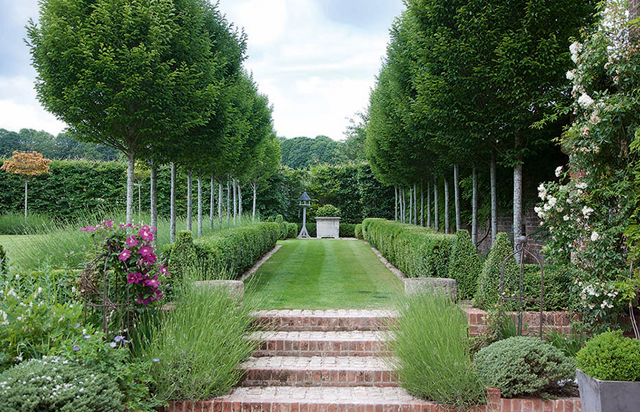A time for good manors.
Edward Cunningham of Knight Frank is in upbeat mood. ‘All of a sudden, we’re seeing light at the end of the tunnel. The market for country houses valued at £2 million-plus is on the move again, with more viewings, deals being done privately and on the open market, and more stock being offered for sale,’ he reveals. And, although it’s still early days, Mr Cunningham confirms that first reactions to the recent launch of Georgian, Grade II-listed The Little Manor at Lower Woodford, near Salisbury, Wiltshire, at a guide price of £2.5 million through Knight Frank (01962 850333) and Strutt & Parker (01722 344042), have been encouraging.
Previously a farmhouse on the Earl of Chichester’s Great Durnford estate, when it was known as Avon Farm, The Little Manor was ‘rundown and very depressed’ when John and Caroline Paul bought it some seven years ago. Having already completed several successful renovations, Mrs Paul set out to transform the house on the banks of the River Avon using her own tried-and-tested formula.
Unlike most house-buyers, who tend to tackle the house first and then move onto the gardens. Mrs Paul finds that things work better the other way round: ‘I prefer to start with the garden, which creates a framework and a structure for the house, and always takes a few years to settle in. A local man helped me to plant the hedges and trees, but when it came to the bigger mature ones, we had to get a digger in. Of course, this was during one of the wettest winters in years, and we had to re-level the ground afterwards.’

The Little Manor at Lower Woodford in Wiltshire, has been given an elegant makeover, of both the house and garden. £2.5m.
She continues: ‘After that, it was more or less plain sailing and, by the second year, I had a clear idea of what planting I wanted to do. I’ve always loved pale colours—blues, white and silver—and the interplay of various shades of green. Some people say that there’s a French feel about this garden, and I think that this one works.’
Certainly, that ‘French feel’ translates perfectly into English in The Little Manor’s pristine, 1.18 acres of garden: in the avenue of mop-headed holm oaks with lavender feet leading to the courtyard; in the south lawn surrounded by pleached limes under-planted with box hedging, where roses, irises, lavenders, catmints and yews abound; and in the hornbeam avenue underplanted with lavender. Pots, planters and gates lead the eye in this most romantic of gardens.
After two years spent laying out the garden, the next 18 months saw the manor’s 5,609sq ft of interior space reconfigured into a coherent ensemble of family and entertaining rooms. This included the addition of a south-facing drawing room, with French doors opening onto a terrace on the south and west sides—the family room, kitchen, breakfast room and sitting room all either face or open onto the same terrace.
Upstairs, redundant dressing rooms were converted to bathrooms in three of the bedrooms; the fifth bedroom has a shower room. Inside the house, as in the garden, the use of pale colours helps to create an ambience that is cool, relaxed and elegant. Outside, a three-bay garage has a loft room with planning consent for staff accommodation.
Elsewhere, buyers prepared to look north of London will find that a budget of £2.5m buys a historic manor house with almost twice the living space— and three times the gardens and grounds of Mr and Mrs Paul’s Wiltshire gem—in rural Northamptonshire, the often-overlooked county of squires, spires and outstanding schools. That’s the price quoted by Strutt & Parker’s Market Harborough office (01858 433123) for Grade II*-listed The Manor House in the ancient village of Brigstock, eight miles from Kettering station, which boasts frequent connections to London St Pancras in about an hour.
Originally, The Manor House was a royal hunting lodge in the forest of Rockingham, and various kings from William I onwards lived at Brigstock at some point, although less frequently than at nearby Geddington. Its listing suggests that the present house was built in the late 15th century by the Montague family, who leased the manor from the Crown in 1449 and extended it in the mid 1500s, when the hall and porch roofs were raised and a gallery inserted. The house eventually passed to the Dukes of Buccleuch, who restored it in the mid 1800s, and, in 1890, commissioned the eminent Victorian architect John Alfred Gotch to further extend it. For several decades after the Second World War, The Manor House was owned by British Steel, before reverting to private use.
In 1998, it caught the eye of Nottinghamshire entrepreneur Andrew Jones, who quickly bought it and embarked on a lengthy renovation programme of the house and its medieval moated grounds.

The Manor House at Brigstock in Northamptonshire blends its medieval roots with modern comforts. £2.5m.
He vividly recalls: ‘The manor had been less than sympathetically restored, but, thanks to an excellent local builder and advice from English Heritage, we worked our way through it from top to bottom, re-roofing the entire building, restoring windows, installing underfloor heating (there was no central heating) and replacing ugly cement pointing in the stonework with lime mortar. Fortunately, the bedrooms were large enough, with enough windows to allow us to create proper bathrooms without having to knock down walls.’
Centrally sited within its four acres of wooded gardens and grounds, the house is ‘a hidden gem, the existence of which many local people are completely unaware,’ Mr Jones adds.
And even the most extended of families will find room to manoeuvre within its 9,345sq ft of living space, which includes a reception hall, five reception rooms, a kitchen/breakfast room, a family room, a study, eight bedrooms, five bathrooms, a playroom and a gym.






